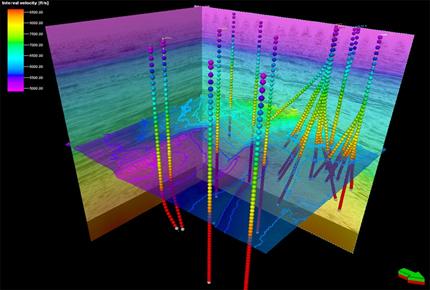Petrel Domain Conversion
The Petrel Domain Conversion module enables quick generation of velocity models based on different types of velocity data.
The module enables you to build multiple velocity models to test different velocity parameter scenarios and obtain a better understanding of the structural uncertainty. You can calibrate well with seismic velocities obtained from processing to build more accurate velocity models and use 3D grid properties for depth conversion, which is useful for conversion of complex structures, such as reverse fault and salt environments. Conversions within the same domain (time-to-time and depth-to-depth) can be used for flattening, AVO, and 4D seismic workflows, as well as workflows calibrating prestack depth migration data to well markers.
Features
- The standard layer-cake approach is used for velocity model construction, providing the user with the freedom and opportunity to select velocity variations for each layer—preserving the relationships between faults and horizons.
- Velocity functions handled are linear functions such as V=Vo, V=Vo+kZ, V=Vo+k(Z-Zo), and V=Vo+kT. Average and interval velocity cubes or average grid properties are accepted as input.
- QC tools can be created from the velocity model: point sets, time and velocity logs, time-to-depth and velocity functions, velocity maps, residual attributes on well tops, and well reports.
- Uncertainty analysis can be performed using different seed numbers and variogram parameters to gain a better understanding of the structural uncertainty.
- Domain conversion can be performed backwards and forwards between time and depth for any object, including surfaces, horizons, faults and multi-Z interpretations, points, well data (logs and tops), 2D and 3D seismic data, and pillar and stair-stepped 3D grids.












